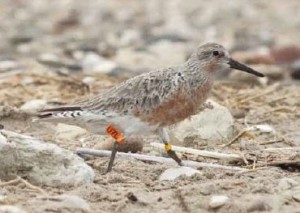Rookery Bay Reserve Serves As Important Stopover Habitat For Migrating Shorebirds
Research staff with Rookery Bay National Estuarine Research Reserve confirmed that a bird documented during a shorebird survey near Marco Island was banded in Argentina. The red knot (Calidris canutus rufa), seen through a spotting scope by Rookery Bay researcher Beverly Anderson, had an orange leg flag bearing the letter-number combination “U7L.” The bird, an imperiled species, was traced back to avian researcher Patricia Gonzalez, head of the Argentina wetlands program Fundación Inalafquen, and Allan J. Baker from the Royal Ontario Museum (Toronto, Canada).
Anderson made contact with Gonzalez to confirm the bird’s record. “I think this is one of the few (if not the only) sightings on the southwest coast of Florida of our orange-flagged red knots,” said Gonzalez, who banded the bird in April of 2012 with a group of high school students near San Antonio Oeste, Rio Negro, in southern Argentina. “The students will be so happy to hear about this resighting,” she added.
Anderson states she has seen more than 80 flagged red knots in the Reserve over the years, and all but this one were wearing lime green flags that designated they were banded in the United States.
this one were wearing lime green flags that designated they were banded in the United States.
“Because it was orange, U7L immediately jumped out as someone very special,” she said.
Reporting a resighting is important because it helps scientists learn more about shorebird migration routes and patterns and locate important stopover and wintering sites. According to Anderson, The red knot has one of the longest migrations of any living creature. In the fall, eighty percent of red knots migrate over 9,300 miles from their breeding grounds Photo courtesy of Martin Arnaldo Fenández on Arctic tundra to Brazil and then on to the southern tip of South America. In the spring, they repeat the journey travelling from South America to Delaware Bay and to the Arctic. Some red knots, about twenty percent, migrate a shorter distance to spend their winters along the Atlantic and Gulf coasts of the southeastern United States and these are the ones typically seen along Florida beaches. Long distance migrant red knots rarely show up in Florida.
Rookery Bay National Estuarine Research Reserve encompasses 110,000 acres of coastal lands and waters on Florida’s Gulf Coast managed by Florida Department of Environmental Protection’s Florida Coastal Office, in cooperation with NOAA. For more information about the sighting, visit www.rookerybay.org.

Leave a Reply
Want to join the discussion?Feel free to contribute!